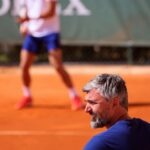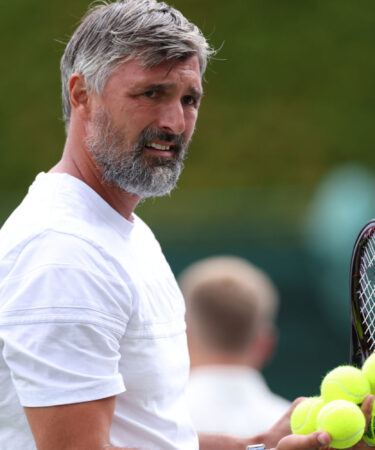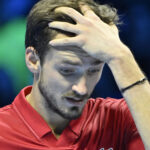July 9, 2001: The day Goran Ivanisevic finally won Wimbledon
Every day, Tennis Majors takes you back in time to relive a tennis event which happened on this specific day. On this day in 2001, rain caused the Wimbledon final to be moved to Monday and a wild card entrant created history at the All England Club
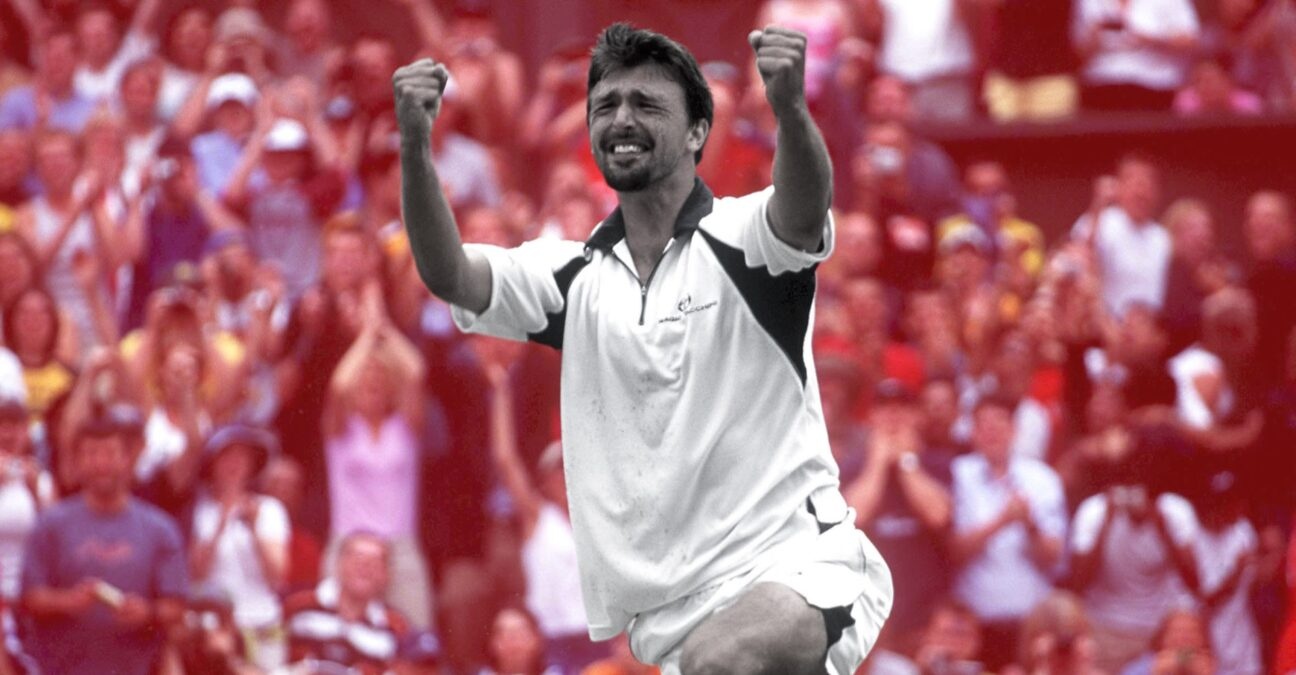 Goran Ivanisevic On this Day 2001
Goran Ivanisevic On this Day 2001
What happened exactly on that day
On this day, July 9, in 2001, Goran Ivanisevic, who had previously finished as runner-up at Wimbledon on three occasions, finally triumphed at the All England Club after a thrilling five-set battle against Patrick Rafter (6-3, 3-6, 6-3, 2-6, 9-7). Ivanisevic, on the verge of tears, finally managed to master his nerves in one of the most emotional final games in tennis history. The Croat, whose ranking had dropped to No 125, was the first player to win a Grand Slam title after receiving a wild card to enter the main draw.
The players: Goran Ivanisevic and Patrick Rafter
- Goran Ivanisevic: one of the best players never to win Wimbledon
Goran Ivanisevic was born in 1971 and had his breakthrough year in 1990, at the age of 19. That year, he made himself famous by reaching the quarter-finals at Roland-Garros after defeating world No 3 Boris Becker in the first round, just before reaching the Wimbledon semi-finals, where Becker got his revenge (4-6, 7-6, 6-0, 7-6).
In 1991, Ivanisevic’s season was disturbed by off-court issues; his country, Yugoslavia, was ravaged by civil war and he couldn’t focus on tennis. In 1992, he returned to peak form and, firing 206 aces during the tournament, reached the Wimbledon final where he was defeated in five sets by Andre Agassi (6-7, 6-4, 6-4, 1-6, 6-4). In the five following years, Ivanisevic remained a solid top 10 player, claiming 14 titles and reaching at least the quarter-finals in every Grand Slam tournament.

In 1994, after reaching a second Wimbledon final (lost to Pete Sampras, 7-6, 7-6, 6-0), the Croat obtained his highest ranking of world No 2. Left-handed, his attacking game relied mostly on a huge and an extremely precise serve – in 1996, he served an unbroken record of 1,477 aces in one season. Ivanisevic was also known for his emotional outbursts and his habit of smashing an unusually high number of racquets. In 1998, he suffered a heartbreaking third loss in the final at Wimbledon, where he was close to going ahead by two-sets-to-love before he was edged out again by Sampras (6-7, 7-6, 6-4, 3-6, 6-2). Devastated by this defeat, which he called “the worst moment of his life”, Ivanisevic would not win a single tournament in the next 24 months and would see his ranking drop as low as No 134 in November 2000. In 2001, his best result was reaching the quarter-finals in Milan (lost to Roger Federer, 6-4, 6-4).
- Patrick Rafter: the humble gentleman who won the US Open twice
Patrick Rafter was born in 1972 and turned pro in 1991. The Australian had not achieved any remarkable results in his early career, claiming only one title before 1997, which came at the 1994 Manchester Open. In 1997, his career suddenly took off when he reached the semi-finals at Roland-Garros, defeated by Sergi Bruguera (6-7, 6-1, 7-5, 7-6). A few months later, he claimed the US Open title to many people’s surprise. It was only his second career singles title. On his way, he had defeated Andre Agassi (then ranked No 63 in the world, 6-3, 7-6, 4-6, 6-3), world No 2 Michael Chang (6-3, 6-3, 6-4) and Greg Rusedski in the final (6-3, 6-2, 4-6, 7-5). In 1998, his disappointing results in the first half of the season made John McEnroe criticize him as a one-Slam wonder and Pete Sampras said that Rafter would need a second Major title to be called a great player.
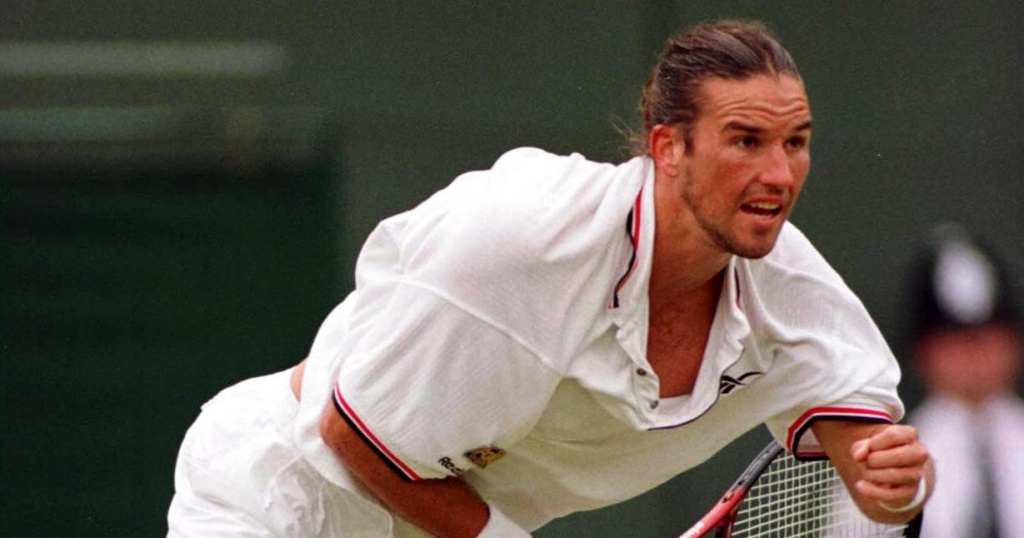
As a response, in the summer of 1998, Rafter would claim titles in Toronto and Cincinnati (edging Sampras in the Cincinnati final, 1-6, 7-6, 6-4). Riding the wave of confidence, Rafter would collect a second US Open crown, defeating Pistol Pete a second time (6-7, 6-4, 2-6, 6-4, 6-3) in the semi-finals before he beat fellow Australian Mark Philippoussis (6-3, 3-6, 6-2, 6-0) in the first all-Aussie Grand Slam final since 1970. He was described by Bud Collins as “a humble man known for a gracious manner on the court, great generosity and a gentlemanly demeanour at all times”.
With his sublime serve-and-volley game, he was desperately chasing a Wimbledon title having reached the semi-finals in 1999 (defeated by Andre Agassi, 7-5, 7-6, 6-2) and finishing runner-up in 2000 to Pete Sampras (6-7, 7-6, 6-4, 6-2).
The place: Wimbledon, south-west London
Wimbledon is the oldest and the most prestigious tennis tournament in the world. Held by the All England Lawn Tennis and Croquet Club since 1877, it moved into its current location in 1922, the same year when the Centre Court was built. Considered by many as the most intimidating court in the world, with its famous Rudyard Kipling quote above the entrance (“If you can meet with triumph and disaster and treat those two impostors just the same”), the Centre Court had seen the best players of all time competing for the title.
After the US Open switched to clay and then hard court in the 1970s, and after the Australian Open switched to hard courts in 1988, Wimbledon remained the only Grand Slam tournament to be played on grass, a surface that is usually more suitable for serve-and-volley players. Not only did Wimbledon retain its surface, but it also maintained old-fashioned traditions such as its all-white dress code.
The facts: The Ivanisevic vs Rafter final gets moved to Monday
In 2001, Ivanisevic, three-times a runner-up at Wimbledon in the 1990s, entered the Championship draw thanks to a wild card. With his current ranking of No 125 (No 121 at the time of the cut-off), he was supposed to play qualifying but due to his previous performances at the All England Club, the committee had decided to award him with an invitation. No one ever used that opportunity better than him.
Ivanisevic got lucky in the first round as he played against qualifier Fredrik Jonsson, whom he beat 6-4, 6-4, 6-4. By beating world No 22 Carlos Moya in the second round (6-7, 6-3, 6-4, 6-4), he had already justified his wild card. In the third round, he defeated the rising American star Andy Roddick in four sets, 7-6, 7-5, 3-6, 6-3. In the fourth round, he beat Greg Rusedski in straight sets, and in the quarter-finals, he eliminated world No 3 Marat Safin, 7-6, 7-5, 3-6, 7-6. Against all odds, Ivanisevic had made his way to the semi-finals when everyone thought his days at the top were over. In an epic five-set battle, spread over three days, he managed to beat the crowd favourite, Tim Henman (7-5, 6-7, 0-6, 7-6, 6-3). The Croat was going to compete in the Wimbledon final for the fourth time in his career.
Between Ivanisevic and his dream of winning the Wimbledon title stood Patrick Rafter. The Australian, world No 10, had been expected to triumph at Wimbledon one day. One of the last players to consistently play serve-and-volley, his game perfectly matched the grass courts, and the previous year, he had been defeated only in the final by Pete Sampras. This time, Rafter took his revenge from the 1999 semi-final, beating Agassi to reach the final at Wimbledon again.
Due to numerous rain delays during the tournament, the final was delayed and played on a Monday. New tickets had been sold, and as the stands were full of Croat and Australian spectators, the match started in front of an excited crowd. Maybe distracted by the enthusiasm of his fellow Aussies, Rafter lost his serve at the very start of the match, which cost him the first set, which Ivanisevic won 6-3. In the second set, the Croat struggled with his serve, which was his biggest weapon, and complained about shoulder pain. Rafter evened the score, 6-3.
Goran took the third set, breaking his opponent’s serve at 3-2 thanks to two amazing returns. The Croat had never been so close to his lifetime dream. Starting to feel the pressure, he had his first emotional outburst of the match after he double-faulted on a break point. Kicking the net, throwing his racquet away and swearing at the umpire, it looked like the good old Goran was back, consumed by his usual demons. There was too much at stake for him to get totally overwhelmed by anger, though. After losing the fourth set, 6-2, Ivanisevic gathered himself together in the final set, which did not surprise Pat Rafter: “It was too big an occasion for him to let that sort of thing worry him and get him down.”
In the fifth set, the atmosphere in the stadium was tense enough to be cut with a knife. At 7-7, thanks to a return winner, Ivanisevic broke Rafter’s serve. He waved his fist at his box while walking to his chair. For the first time in four Wimbledon finals, he was about to serve for the match, and his serve was maybe the most lethal in the world. And yet, this same serve, which had produced 211 aces already since the start of the tournament, almost let him down, in that last game.
At 15-15, he made a first double fault. At 15-30, he fired an ace, on his second serve sending chalk flying. Another ace followed at 30-30. Ivanisevic was now one point (one ace?) away from sealing the most incredible Wimbledon triumph of all time. He went into his serving position with teary eyes.
Double fault.
A service winner on the next point gave him a second championship point.
Double fault again.
A missed passing shot from Rafter gave Ivanisevic with a third match point. Kneeling on the ground, praying to the skies, and eventually shaking his arm loose, the Croat tried to settle down before this latest attempt. This time, despite a perfect approach to the net, a magnificent lob from Rafter evened the score again. One service winner later, Ivanisevic obtained a fourth opportunity to make his lifetime dream finally come true. He missed the first serve, but he did not double fault this time. Rafter hit his return straight into the net, and Ivanisevic let himself fall on the grass in jubilation.
After three losses in the final, he had come back from oblivion to triumph at Wimbledon, a feat that no one believed he could achieve. In a final act of sportsmanship, Rafter gave a hug to a weeping Ivanisevic before the new Wimbledon champion climbed into the stands to celebrate his victory with his father and team.
What next? Rafter hangs up his racquet in 2001 while Ivanisevic retires in 2004
“I don’t know if someone is going to wake me up and tell me I haven’t won again,” said an emotional Ivanisevic afterwards. “This was my dream all my life. I came here and nobody thought about me, but here I am holding the trophy.”
Rafter, after praising his opponent’s performance, shared his bitterness with the press. “I’m sick of making bloody history. (…) Someone has to lose and I’m the loser once again.”
The 2001 Wimbledon final was the last remarkable performance for both Rafter and Ivanisevic. Both had been struggling with shoulder injuries for a while already. Rafter’s last appearance would be the Davis Cup final at the end of 2001 while Ivanisevic would almost disappear from the tour in 2002, playing only 16 matches in the next two years. In 2004, after a farewell appearance at Wimbledon, where he would reach the fourth round (defeated by Lleyton Hewitt, 6-2, 6-4, 6-3), Ivanisevic would finally call time on his career.
